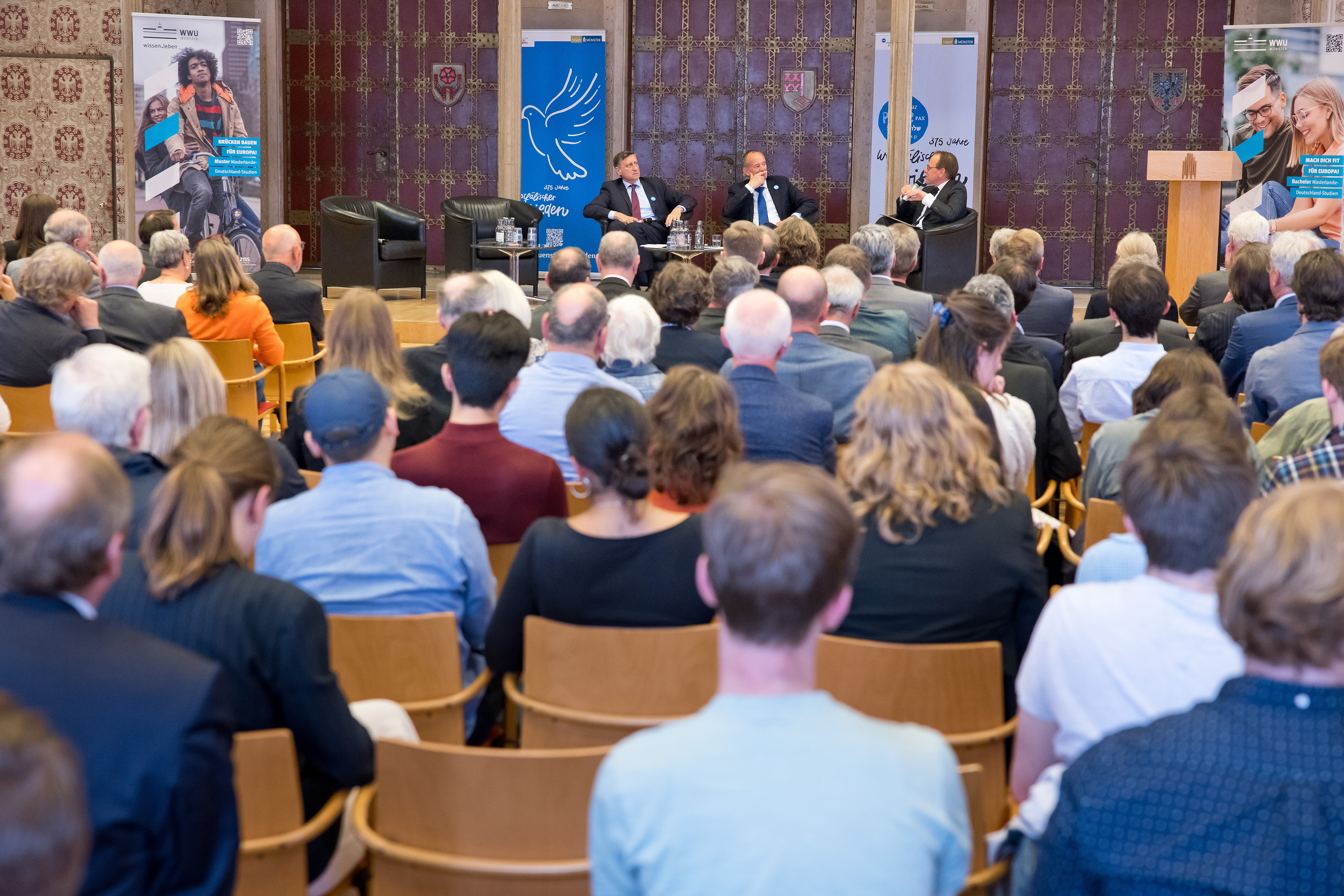The Day of the Netherlands
On May 15, 1648, the first part of the Peace of Westphalia was ratified in the Peace Hall in Münster with the Spanish-Dutch Peace Treaty. Since then, Münster and Westphalia have been regarded as a symbol of the attempt to create lasting peace in a world of individual states. For this reason, the Centre for Netherlands Studies (ZNS), in cooperation with the City of Münster and the University of Utrecht (Netherlands), organized a day of German-Dutch encounters. Among others, 60 Dutch students from the University of Utrecht traveled to Münster to explore the city of peace and its German-Dutch history together with German students from the House of the Netherlands. The day's program consisted of several points, starting with a poetry competition in the House of the Netherlands, a carillon, the arrival of the Peace Fire, a symposium and the inaugural lecture by the new head of the ZNS, Prof. Dr. Jacco Pekkelder.
Peace poems
Class 4b from Clemens-Dülmer-Schule in Bocholt and Euregio-Gesamtschule Epe in Gronau were honored at the House of the Netherlands. Both had won the Dutch poetry competition organized by the ZNS and the Münster district government on the subject of "Peace" against stiff competition. The winning certificates were presented by Peter Schuurman, Consul General of the Kingdom of the Netherlands, and Matthias Schmied, Director of the Schools Department of the Münster District Government.
Carillon
The honorary carillonneur James Schäfer gave a concert on the carillon in the Stadthausturm for the "Vrede van Munster": from 2 p.m. he played melodies such as "Mijn Nederland", "Midden in het leven" and the European anthem.
Arrival of the peace fire
The peace-fire, carried by two runners from Coesfeld, then arrived behind the historic town hall and was handed over to Münster's mayor Angela Stähler by the Commissioner of the King of the Province of Overijssel, Andries Heidema. The background to the bonfire goes back to May 5th, when the Netherlands traditionally celebrate "Bevrijdingsdag" to mark the end of the German occupation after the Second World War. On the night of May 4th to 5th, a bonfire is lit and distributed by runners throughout the Netherlands, opening various liberation festivals. As a sign of international understanding and European cohesion, the bonfire came to Germany for the first time as part of the anniversary year. Before it came to Münster, it had passed through Zwolle, Enschede, Gronau and Coesfeld, thus linking the "Bevrijdingsdag" with the 375th anniversary of the Spanish-Dutch peace. The fire, a symbol of peace, freedom and democracy, then continued to burn in the form of a candle in the historic town hall.
Symposium: The Netherlands, Germany and Europe in times of declining peace. Encounters - Dialogues 1648 - 2023
This was followed by the symposium "The Netherlands, Germany and Europe in times of declining peace", which was attended by more than 300 international guests in the Rathausfestsaal. The Director of the CNS, Prof. Dr. Jacco Pekelder, first discussed the significance of the Peace of Westphalia and the current situation in Europe with the German Ambassador from The Hague, Dr. Cyrill Jean Nunn, and the Dutch Ambassador from Berlin, Ronald van Roeden. Afterwards, historians from Germany (Dr. Justus Nipperdey, Saarbrücken), the Netherlands (Prof. Dr. Beatrice de Graaf and Dr. Jorrit Steehouder, Utrecht) and the USA (Prof. Dr. Bruce Schulman, Boston) outlined different perspectives on the Peace of Westphalia and its ongoing significance for European relations.
"The Netherlands, Europe and Power in the Middle: 1648 - 1848 - 2048": Inaugural Lecture Prof. Dr. Jacco Pekelder, Professor of Modern and Contemporary History of the Netherlands
The day finally culminated in the inaugural lecture by Prof. Dr. Pekkelder on the topic of "The Netherlands, Europe and the power in the middle: 1648 - 1848 - 2048". He emphasized how exogenous developments and inter-Dutch cultural processes sometimes influenced the relationship with Germany just as much as direct contact did. A look into the future year 2048 showed that these external influences could steer the neighborhood in unexpected directions.
You can download the complete lecture here (pdf, 1.21 MB). (pdf, 1,21 MB)





